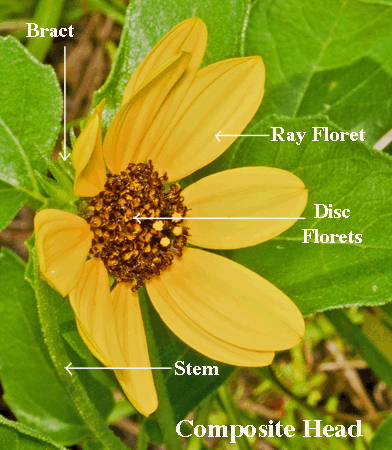Composites (Family Asteraceae) in the Christopher B. Smith Preserve
 Family Asteraceae Characteristics: This family includes asters, daisies, sunflowers, and other composite flowers. As shown in the photograph, a composite flower head consists of a small cluster to hundreds or thousands of disc florets (flowers) grouped together to form a structure that looks like a single flower. Around the disc florets are ray florets, normally referred to as petals. Bracts (modified leaves or scales) are positioned at the top of the stem under the flower. Members of the family include herbaceous plants, shrubs, vines, and trees.
Family Asteraceae Characteristics: This family includes asters, daisies, sunflowers, and other composite flowers. As shown in the photograph, a composite flower head consists of a small cluster to hundreds or thousands of disc florets (flowers) grouped together to form a structure that looks like a single flower. Around the disc florets are ray florets, normally referred to as petals. Bracts (modified leaves or scales) are positioned at the top of the stem under the flower. Members of the family include herbaceous plants, shrubs, vines, and trees.
Interactions in the Smith Preserve: Members of the family provide nectar, pollen, and habitat for many different species of animals. Seeds are eaten by birds. Foliage is used for nesting materials. The 27 species of Family Asteraceae that have been identified in the Preserve are listed below. Click on the species name to learn more about each one.
Species Name |
Common Name |
Common Ragweed |
|
Saltbush |
|
Coastalplain Honeycombhead / Yellow Buttons |
|
Beggarticks |
|
Jack-In-The-Bush |
|
Purple Thistle |
|
Blue Mist Ageratum |
|
Dwarf Canadian Horseweed |
|
Tickseed |
|
False Daisy / Yerba de Tago |
|
Red Tasselflower |
|
Purple Tasselflower |
|
Dog Fennel |
|
Beach / Dune Sunflowers |
|
Camphorweed |
|
Chapman's Blazing Star / Chapman's Gayfeather |
|
Rose Rush |
|
Climbing Hempweed |
|
Coastal-Plain Palafox |
|
Narrowleaf Silk Grass |
|
Pluchea / Salt Marsh Fleabane |
|
Common Sowthistle |
|
Wedelia / Creeping Oxeye |
|
Bahaman Aster |
|
Rice Button Aster / Bushy American-Aster |
|
Elliott's Aster |
|
Oriental False Hawksbeard |
© Photographs and text by Susan Leach Snyder (Conservancy of Southwest Florida Volunteer), unless otherwise credited above.
